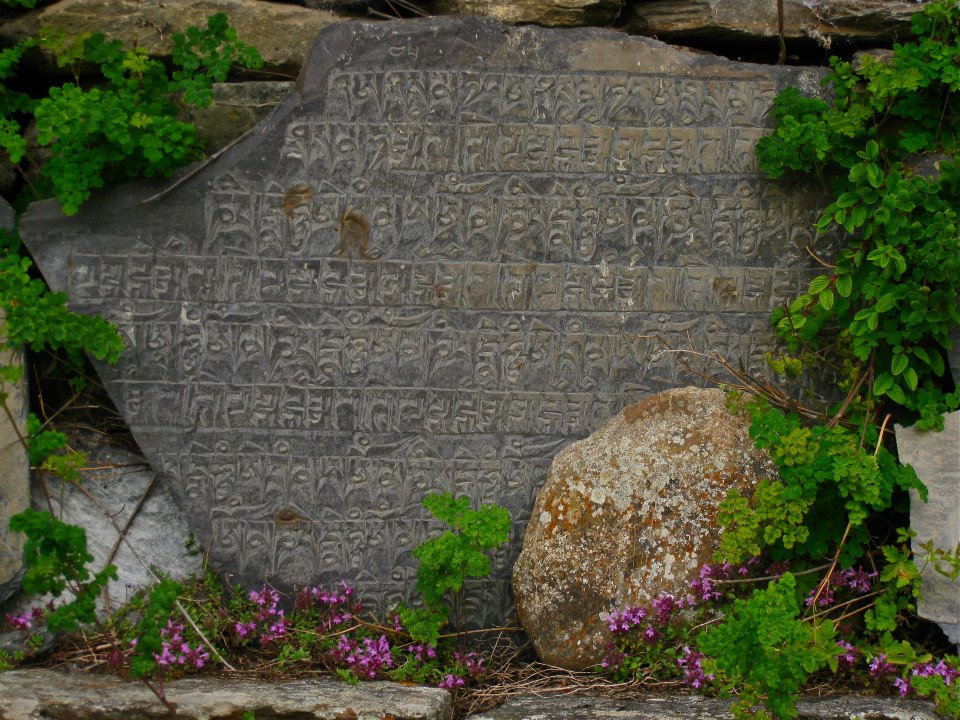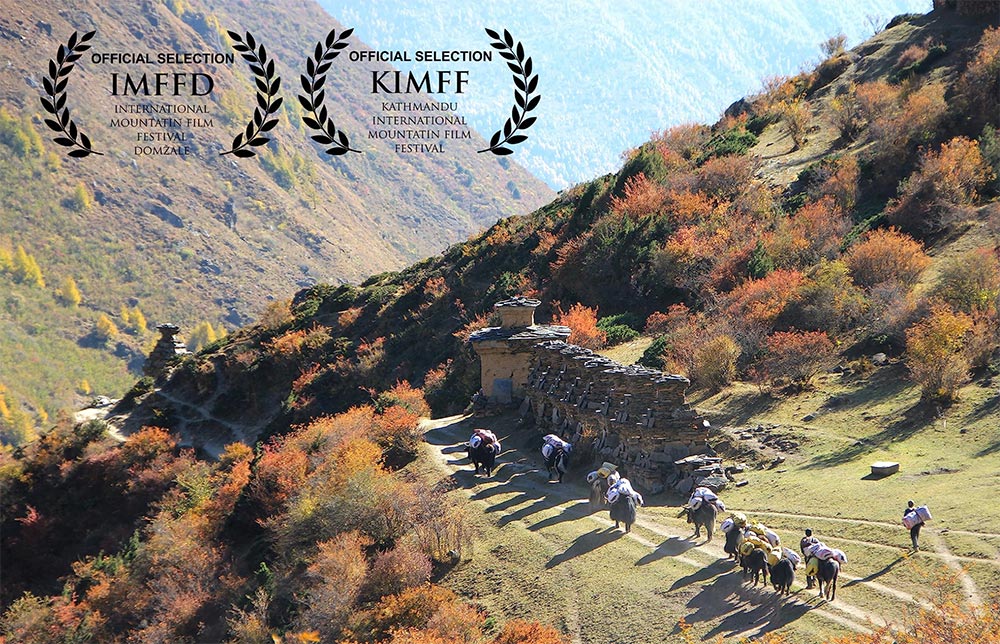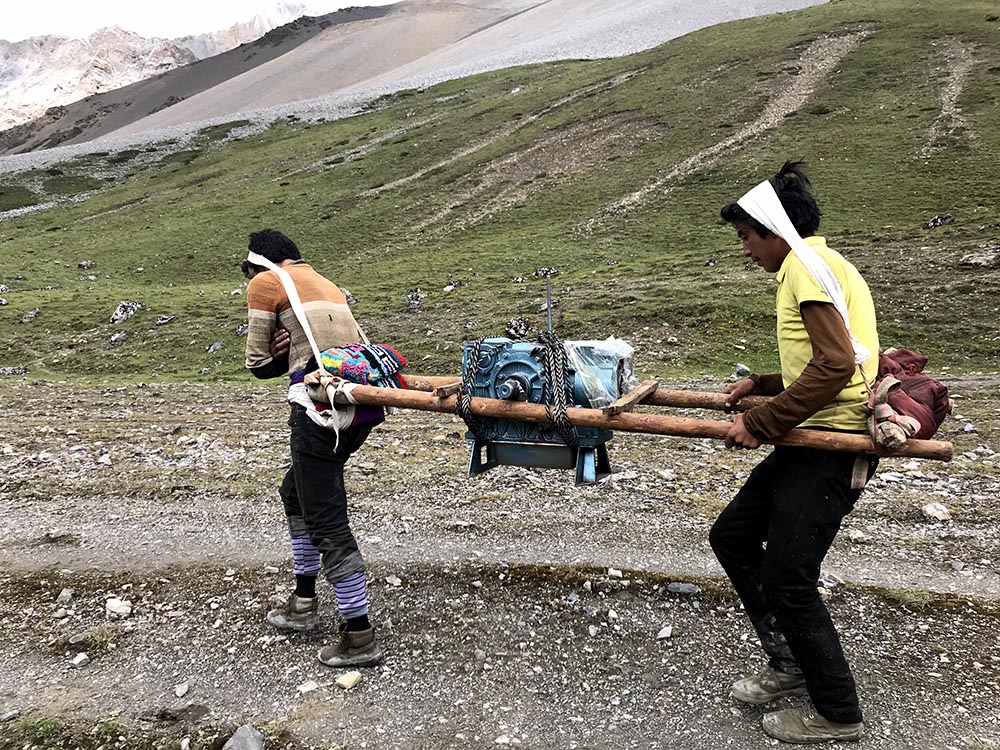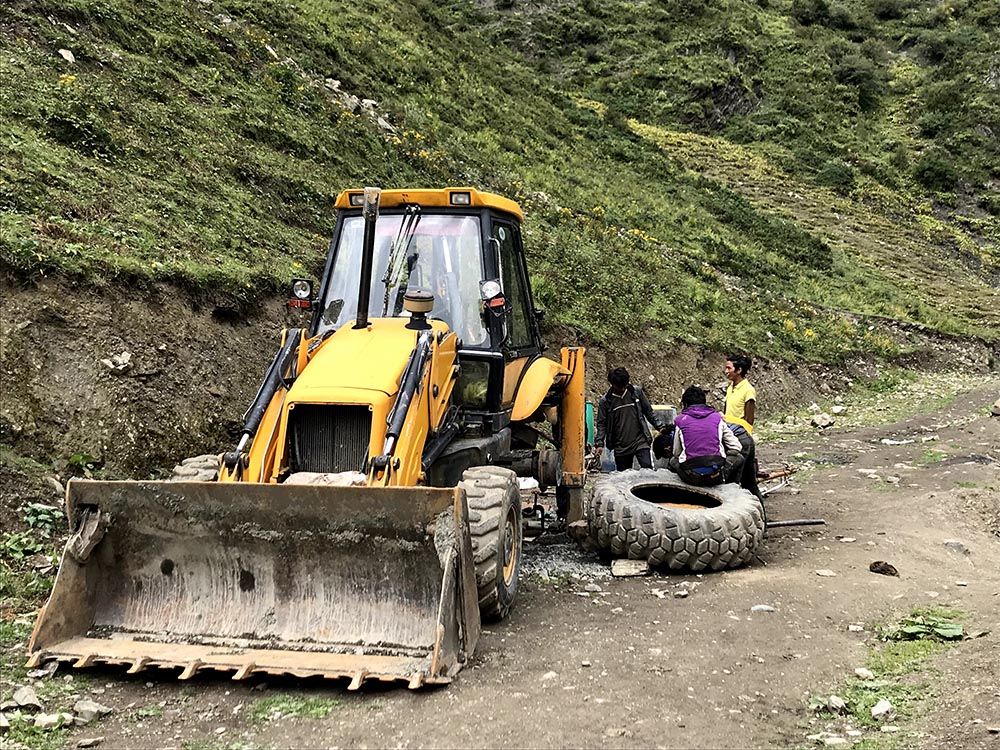Stories of Infrastructure and Environmental Justice in Nepal
For Indigenous communities living in remote Himalayan areas of Nepal, infrastructural developments are agents of profound change. Their resource-based livelihoods and the location of their homes in vulnerable environments make them particularly sensitive to road construction. The Tsum Valley in the Manaslu Conservation Area is one such place where government narratives and local Indigenous imaginaries of infrastructural futures diverge. Rather than opposing the construction of a new road, people advocate for the respect of Indigenous relations to land and kin.
On a clear winter morning in January 2014, I stood on the veranda of Dhawa Gyanjen’s house in Tsum, a long mountain valley in the Nepal Himalaya, bordering the Tibet Autonomous Region (TAR). The sky was a bright blue, and frost glistened damply on the grass of the front yard. The days had grown increasingly cold. I was watching a group of villagers who sat in a circle on plastic chairs in the warmth of the high-altitude sun, debating the arrival of a long-anticipated road. “What good is a road if it does not go from village to village?” asked a man sporting a faded blue sweater, his eyes shaded with sunglasses. “It will risk the pollution of our river and streams,” responded another, with thin graying hair hanging loose over his shoulders. “Besides,” the latter said, turning more serious, “it might also cause damage to our ancestral places.” A girl from a neighboring house in the village appeared, filling up cups of steaming tea for everyone from a thermos.
The heavy construction machine that was clearing ground for a motorable road through Tsum and up to the Tibetan border had reached the village boundary about a week prior. Having removed soil and scrub across mountain pastures and below cliffsides for the past several months, the excavator was now parked for the barren winter, when the valley sits beneath thick blankets of snow. Dhawa, who lives in Kathmandu but was in Tsum to visit his aging father, had sent handwritten letters to elders and knowledge holders of all remaining villages along the planned road, calling on them to discuss its further alignment after snowmelt in spring. People needed to decide the road’s route through the valley if they did not want it to follow the alignment established by government engineers, which would have considerable effects on Indigenous relations to land and kin. Should the road follow the northern banks of the Shyar Khola, the main river running through the valley, and bypass some villages but protect sensitive mountain landscapes? Or, instead, should it cross the river more than once, lead through all remaining villages, and potentially damage the interconnected network of human and other-than-human beings that sustain Indigenous life? The people who gathered in Dhawa’s front yard had already been discussing the matter for hours.
Members of the Indigenous Tsum community had been asking the government for a road since the region was opened for controlled tourism in 2008. At that time, the nearest domestic road head was in Arughat, a sprawling market town along the Budhi Gandaki River, a five day walk to the south, from where one could reach Kathmandu in another day by bus. Daily essentials, such as rice, salt, and tea, but also kitchen utensils, batteries, and clothes were imported from Arughat on mules via a footpath that was often precarious during summer, when monsoon rain washed away sections in landslides. A less treacherous, and much shorter, route was to cross the mountain pass into China, where a dirt road puckered with potholes snaked downhill to merge with a highway that led to the larger town of Dzongka. For people in Tsum, a road connecting these two loose ends embodied development; it promised economic growth, job opportunities, education, and health care. Yet when the government, over a period of two years in 2011 and 2012, sent engineers to the region to conduct a feasibility study and sketch a detailed plan of the road, the situation quickly turned awry.
In what follows, I present the story, through pictures and text, of what went wrong. I analyze and interpret tensions at the intersection of Indigenous knowledge systems and state-led development programs to highlight the different actors, political stakes, and invested perspectives that continuously collide amidst current infrastructure projects in Nepal. In doing so, I bring attention to the critical role of local communities in Himalayan homelands – and help to amplify another kind of story that is sometimes silenced by the noise from political centers.
The promise (and perils) of infrastructure in Nepal
Infrastructure appears at the center of current political debates in Nepal. It is framed as a nation-building project of a fledgling democratic state, and the Nepali government is seeking to build roads to every town and sizable settlement in the country. 1
Promising to boost regional development and introduce new forms of mobility, these paved, gravel, and dirt roads are part of an ambitious effort to strengthen rural livelihoods after a social movement ended the decade-long civil war in 2006. According to national development narratives, roads will ultimately lead to greater wellbeing by extending market relations to hill and mountainous areas, which have some of the lowest road densities in the world. 2
Governing the allocation of resources for road construction projects in Nepal is the National Planning Commission (NPC). Since its establishment in 1956, the NPC has been implementing a series of periodic infrastructure development plans. Each of these periodic plans specifies development policies and programs under a national vision, and road building has continuously been given the highest priority to help consolidate a modern bureaucratic state. Once the government approves a road project and a registered construction firm emerges successfully from the tendering process, the firm outsources work to local contractors, creating a broker economy of both public and private actors.
Social anthropologist Brian Larkin writes that infrastructures, roads included, are ultimately matter that enable the movement of other matter. They facilitate material flows and allow for their exchange across space. 3 But roads also exceed their most obvious form. “In contrast to their representations on maps as seemingly smooth and straightforward lines,” Agnieszka Joniak-Lüthi explains, roads are also “a place of experiencing, a place where ideas, things and relationships come into being and fall apart.” 4 The capacity to connect and disconnect is a persistent feature of infrastructures. Roads bring resources, opportunities, and relations within reach of some, while often restricting them for others. They do not simply reflect existing inequalities, but may engineer and entrench new forms. In other words, roads shape life in profound and sometimes unexpected ways. 5
The complex material and social realities of roads are visible across Nepal’s Himalayan regions. It is here that infrastructure development ties closely into practices of mapping, itself a process of control that political scientist James Scott identifies as a territorial tool through which states make geographically remote places more legible. 6 Especially for Indigenous Peoples living in hill and mountainous areas, the idea of a road is a highly contested one. 7 Their communities’ multiple forms of relatedness with the environment stand in stark contrast with the expansion of capitalist frontiers and resource extraction pushed by the government. Consequently, infrastructure development programs are often seen as a continuity of the historical marginalization and dispossession that Indigenous Peoples have been facing in Nepal. Recent calls for Indigenous sovereignty and environmental justice are increasingly pointing out violent infrastructure practices in an effort to protect land, mountains, and water, thus challenging linear narratives of development emanating from the capital Kathmandu.
Infrastructure and Indigenous relations of ethics and care
Once the intense debate between the villagers who had gathered in Dhawa’s front yard ceased, one after another prepared to leave. The atmosphere was tense. Having reached no agreement on an alternative road alignment through Tsum, they pledged to resume the conversation the next day. I wondered what had happened that motivated people to oppose current road construction plans so vehemently. Having sensed my interest in the matter, Dhawa’s father invited his son and me to a more comfortable seating arrangement inside the house. Tsering Phuntsok had high cheekbones and a beguiling smile. He used to be a savvy trader but now, at age seventy-four, he spent most of his days taking yaks from the village to high alpine pastures. Tsering Phuntsok pulled out a plastic jug filled with arak, the local whiskey distilled from barley, and sloshed some of the clear liquor in three stained ceramic cups. He then reminisced about his encounter with the development planners in Tsum: “I was walking home from a local pasture when I saw the engineers doing their work. They carried survey instruments and measuring tapes and, along the main footpath meandering through the valley, painted red signs on our gompas, khani, chorten, and mani walls, mapping where the road would go.” 8 The unexpected meeting with the engineers was a crucial moment for the elderly man – and one that changed his perception of development.

Fig. 2: Some carved mani stones
have a history of 400 years or more.
In Tsum, chorten, khani, and mani walls are spiritual as well as geographic markers, as they protect people and territories and are embedded in everyday place-making practices [Figs. 1-2]. Made of rocks and carved stones, these markers are found in villages, on ridges and hillocks, as well as along walking trails. Together with mountains, lakes, and trees, they form part of a complex landscape that is animated by other-than-human beings that bestow blessings, generating the conditions for human life to flourish. Human inhabitants, in turn, maintain their relatedness with the animated landscape through institutions, narratives, and bodily practices, such as circumambulating these markers and performing prostrations, or by integrating them into larger pilgrimage circuits. This interconnected system of responsibilities creates a sense of place and home for the local community. If disrupted, environmental calamities (e.g., storms, landslides, and droughts) or sicknesses are believed to likely follow. Tsering Phuntsok pointed out that while it seemed easiest to build the road along the locally used walking trail, it would inevitably damage some of these ancestral places and thus violently disrupt villagers’ embodied practices of care for the land and its beings.
Talking with Sonam Lama, a professionally trained architect and community member based in Kathmandu, I learned that the Tsum road was categorized as a “national highway” under the Ministry of Physical Infrastructure and Transport’s Strategic Road Network. Under this project, the road would connect the mountainous region to the district capital Gorkha and further to the Madan Ashrit Highway near Bharatpur in the southern Terai, along the border with India. The Madan Ashrit Highway currently carries 90 percent of all international traffic in the country, and its extension to the Chinese border in the Himalayan highlands would create an economic corridor with significant trade and transport prospects.
Sonam further explained that, as a national highway, the road in Tsum was expected to have a width of about ten meters – a scope that would make it profoundly impactful in many ways. Ecologically, for example, it would quickly become a major source of pollution for agricultural fields and grazing grounds and, therefore, would severely affect customary traditions of environmental management such as seasonal irrigation systems. Sonam’s face mirrored this concern. The architect took a deep breath, choosing his words carefully: “Coming from the lowlands, the engineers didn’t know about our various relationships with the land. But they also didn’t ask us.” Sonam indicated that the government failed to consider the environmental consequences of the road. Known as a standard Environmental Impact Assessment, this procedure is used to identify likely adverse impacts before decisions about a proposed development project are made. Impact assessments are technically mandatory in Nepal under the Environmental Protection Act (1996) and Environment Protection Rules (1997), but their enforcement has been largely ineffective. While laws and mechanisms are in place to mitigate potential environmental harm, they are often ignored in practice by both developers and monitoring agencies.
The planned road through Tsum challenged Indigenous practices that ensure mutual flourishing by disregarding responsibilities for all beings present in the landscape. Without any effort to include the local population in the road planning process, villagers were reminded of complex histories of peripheralization they have long experienced as a community living in the Himalayan highlands. For them, full participation in decision-making processes affecting their territory was an important milestone in the project for self-determination and environmental justice.
Not long after the government engineers came to Tsum, community members began to mobilize for an alternative road alignment. People did not oppose the road as such; they still believed in the road as a path to the future that was supposed to bring wealth and prosperity. But they argued for a culturally sensitive road construction that respects Indigenous practices of caring for the land in a fragile mountain environment.
Activist efforts first centered upon Kathmandu. Following a meeting with conservation specialists from the Manaslu Conservation Area Project (MCAP), people organized a workshop in the capital. The workshop fostered a critical dialogue between local leaders and knowledge holders, environmental organizations, and development practitioners in order to achieve a solution for road building based on local participation. Following the recommendations that emerged from the workshop, people formed the Tsum Conservation and Development Committee (TCDC), a local nonprofit organization focusing on the protection of important landmarks and monuments storying local history. In turn, the TCDC prepared a document listing potential environmental harms and endangered ancestral sites. This document was then presented to Chhabiraj Pant, Minister for Physical Infrastructure and Transport, and Ram Kumar Shrestha, Minister for Culture, Tourism, and Civil Aviation. A delegation also went to other national-level government offices, including the Department of Roads, the Department of Archeology, and the Ministry of Forests and Environment.
More publicly oriented, Sonam Lama co-directed a documentary film that portrayed the debate over the planned road, drawing on interviews with local community members. Titled Mani: The Hidden Valley of Happiness at a Crossroads, the film was screened at the Kathmandu International Mountain Film Festival and in several villages in Tsum, as well as in the United States [Fig. 3]. Sonam also wrote articles in the Nepali Times, an English-language newspaper, which addressed the haphazard realities of development programs in Tsum. 9 However, the various efforts toward a self-determined and ecologically sustainable road construction met with little success. As has been observed elsewhere in Nepal, the road was driven by political agendas, as well as by the greed of construction firms and petty contractors wanting to make profit from large government budgets.

Fig. 3: Film Poster for Mani: The Hidden
Valley of Happiness at a Crossroads.
When on a cloudy day in September 2013 an excavator was airlifted to Tsum, people decided to take matters into their own hands. Each time the heavy construction machine reached a village boundary, people gathered and, following intense debates, settled on the direction of the road. They bribed the single young Nepali man from the lowlands driving the excavator who, outnumbered, succumbed to their demands. In fear of attacks to his machine, the driver slept in the excavator for months. Still, he would sometimes wake to a cracked windshield or sugar in the tank (which supposedly clogs the fuel lines and disables the machine). The road successfully diverted from its original direction, but without the proper engineering knowledge, the excavator came dangerously close to the base of a steep cliff. Failure to stabilize the slope for protection triggered rockfall and – when a young village boy walking on the freshly dug road was injured – sparked discussions about whether the balance in the relationships between humans and the animated landscape was being upset.

Fig. 4: Men carrying a new motor for
the excavator across the mountain pass
from China.
Over the following years, progress on the road was slow and hampered by many obstacles. Because the area is not situated in the rain shadow of a mountain range, which is responsible for dry and arid zones in other nearby Himalayan regions such as Manang, Mustang, and Dolpo, summers in Tsum are moist and green. Persistent rainfall turns the ground muddy, leaving most of the road building to spring and autumn. In addition, the excavator itself showed signs of mechanical wear due to abrasion, corrosion, and damage. When the heavy machine broke down and needed to get repaired, spare parts were difficult to source [Figs. 4-5]. Regular fuel shortages, too, caused the machine to be parked and covered with a tarp for weeks at a time. In 2017, four years after construction on the road had started, the excavator reached an active landslide area behind Nile, the last village of the valley on the way to the Chinese border. It took another two years, until 2019, for it to navigate over the difficult terrain, and construction has stalled since.

Fig. 5: The construction machine
is awaiting repair but spare parts
are difficult to source.
Initially delayed by the geography and climate of the Himalayan highlands, the status of the road in Tsum was also affected by government priorities and changing political leadership. Firms and contractors are closely linked to politicians and bureaucrats, making road construction a complicated affair that frequently blurs the boundaries between public and private, legality and illegality. 10 Once envisioned as a transit corridor, the Tsum road was eventually suspended in favor of another, more promising highway through the neighboring valley of Nubri, where the government sought help from the army to expedite construction. Today, nearly ten years after the excavator first landed in Tsum, the distance covered by the dirt road takes people no longer than six hours to walk and even less on horseback. No vehicles or motorcycles are driving on the road in Tsum, and sections of it are now overgrown with bushes and strewn with rocks.
Conclusion
In Nepal, infrastructure programs are an emblem of national progress and resource wealth, but they also organize inequality. Similar to other development projects across the country, the planned road in Tsum emerged as a site of struggle over the representation of Indigenous Peoples. The road was designed and initiated without free, prior, and informed local consent, and the lack of legally recognized mechanisms for dispute resolution left the community with limited options to defend their rights.
Yet the condition of infrastructural suspension fostered stronger human relationships with one another and the land in Tsum. The renewed sense of community that came through shared efforts to resist ongoing practices of capitalism and resource extraction enabled people to work for the legal protection of ancestral sites and the continuation of sustainable relations with the natural world – a sense of kinship – that was central to the defiance of the road.
In 2022, when countrywide local-level elections were held under Nepal’s evolving federal system, people voted for a predominantly Indigenous-led local government in the Manaslu Conservation Area. One year into its tenure, this local body adopted a new law that formally protects Tsum’s Indigenous knowledge systems and customary traditions of environmental management. The Shagya Act, as well as another law recognizing the community’s traditional healing practices (the Amchi Act), requires the informed consent of the local population prior to the approval of federal projects that would affect land, water, culture, and livelihood. This presents an important step in strengthening self-determined development planning and designing more sustainable and sovereign futures for Indigenous Peoples in Tsum, as well as in Nepal more broadly.
Nadine Plachta is Visiting Assistant Professor in the Geography Program at James Madison University. Her work focuses on Indigenous knowledge systems and conservation area policies in the Nepal Himalaya. She has explored this theme in the context of local governance, development discourses and practices, and community resilience. Email: plachtnx@jmu.edu